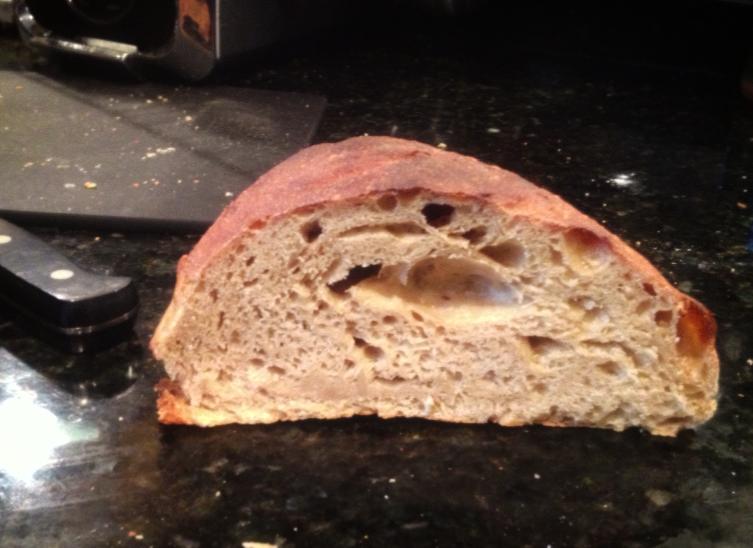What, Where, When:
- Lamb simmered in a slightly sour green sauce.
- Based on a recipe from central France, dated to approximately 1466.
Original Recipe and Translation
Ung haricot de mouton despecié par menuz morceaux et ung poy parboullir. Et, quant il sera parboully, que on le mecte hors de l’eaue tout assec et que on le mecte en ung chauderon. Et que l’on maince l’oignon avec et du percil et puis, quant l’ongnon sera dedans, que on le mecte frire sur le charbon. Et quant on verra qu’il sera presque cuyt, que on y mecte du bouillon de beuf, et du verjust, et de la pouldre dedans. – Le Recuil de Riom, recipe 20.
A stew of mutton cut into small pieces and parboiled a little. And, when it is parboiled, it is taken out of the water and drained and put into a pot. And mince the onion with the parsley, and then, when the onion is put in, one puts it to fry on the coals. And when it is almost cooked, put in beef broth, and verjuice, and powder in it. (Translation by Jennifer Soucy)
Discussion:
This recipe is from Le Recuil de Riom, a source more fully discussed in the full translation. It is a basic brouet of stewed lamb, with onions and a slightly sour green sauce. However, several questions made this redaction interesting, such as how much parsley to add, when to add it, and what to do about verjuice.
- The use of lamb instead of mutton is a question of availability – very few people eat lamb or, especially, mutton in the United States, so I chose to use lamb. The dish is more tender and more delicately flavored due to this choice, which would have been rather extravagant in period.
- Those familiar with the modern dish known as a “haricot” may wonder “Where are the beans?”. None of the medieval recipes for this dish call for beans, even those species known in period. Odile Redon speculates in The Medieval Kitchen that this dish’s name comes from a verb “to cut into small pieces”; it and another dish of similarly-named beans were probably originally combined due to some linguistic confusion.
- The direction to include the parsley when sautéing the onions is surprising to a modern cook, as parsley is rarely included in sauces that will be cooked more than briefly, as it loses its color when cooked. However, I am confident that this was not a mistake by the scribe, as this recipe is nearly identical to another found in Le Menagier de Paris, which also directs the cook to add parsley, and then boil, as does yet a third recipe in Le Vivendier.
- The amount of parsley may have been smaller or larger than what I chose – I added quite a large amount of parsley, so that it would be a defining characteristic for a rather generic dish.
- Verjuice is the lightly fermented juice of unripe grapes, and was very common in the 14th and 15th century kitchen. Unfortunately, it can be hard to find in the modern kitchen, and I did not have any to prepare this dish with. However, as reported by Terence Scully in The Art of Cookery in the Middle Ages, cooks in period were faced with these shortages as well, and found several ways to deal with them – including verjuice made of sorrel shoots or crabapples and even, by the 15th century, the use of citrus juices. Therefore, I believe my substitution in this case was appropriate.
- The spices used are my own blend of Duke’s Spice Powder, based on the following recipe from Le Viandier du Taillevent.
210. Fine Powder. Grind white ginger (9 parts), selected cinnamon (2 parts), lump sugar (2 parts), cloves and grains of paradise (1 part each).
I felt this was appropriate, since Le Recuil only states “powder”, and the two works are compatible in both place and time.
Other notes:
I had to add extra parsley partway through simmering, as it didn’t flavor the sauce strongly enough when only three ounces were added. I did use modern cooking tools – stove, pot, etc. for this redaction.
Sources
1302597
9UMUW2CH
items
1
modern-language-association
0
author
asc
948
https://www.erminespot.com/wp-content/plugins/zotpress/
%7B%22status%22%3A%22success%22%2C%22updateneeded%22%3Afalse%2C%22instance%22%3A%22zotpress-6af49874ef70d71a2a449eb03ecc971e%22%2C%22meta%22%3A%7B%22request_last%22%3A0%2C%22request_next%22%3A0%2C%22used_cache%22%3Atrue%7D%2C%22data%22%3A%5B%7B%22key%22%3A%22HMF6XKTB%22%2C%22library%22%3A%7B%22id%22%3A1302597%7D%2C%22meta%22%3A%7B%22creatorSummary%22%3A%22Hinson%22%2C%22numChildren%22%3A2%7D%2C%22bib%22%3A%22%3Cdiv%20class%3D%5C%22csl-bib-body%5C%22%20style%3D%5C%22line-height%3A%202%3B%20padding-left%3A%201em%3B%20text-indent%3A-1em%3B%5C%22%3E%5Cn%20%20%3Cdiv%20class%3D%5C%22csl-entry%5C%22%3EHinson%2C%20Janet.%20%26%23x201C%3BLe%20Menagier%20de%20Paris%20%28c%29Janet%20Hinson%2C%20Translator.%26%23x201D%3B%20%3Ci%3ELe%20Menagier%20de%20Paris%3C%5C%2Fi%3E%2C%20%3Ca%20href%3D%27http%3A%5C%2F%5C%2Fwww.daviddfriedman.com%5C%2FMedieval%5C%2FCookbooks%5C%2FMenagier%5C%2FMenagier.html%27%3Ehttp%3A%5C%2F%5C%2Fwww.daviddfriedman.com%5C%2FMedieval%5C%2FCookbooks%5C%2FMenagier%5C%2FMenagier.html%3C%5C%2Fa%3E.%20Accessed%2031%20Mar.%202013.%3C%5C%2Fdiv%3E%5Cn%3C%5C%2Fdiv%3E%22%2C%22data%22%3A%7B%22itemType%22%3A%22webpage%22%2C%22title%22%3A%22Le%20Menagier%20de%20Paris%20%28c%29Janet%20Hinson%2C%20translator%22%2C%22creators%22%3A%5B%7B%22creatorType%22%3A%22author%22%2C%22firstName%22%3A%22Janet%22%2C%22lastName%22%3A%22Hinson%22%7D%5D%2C%22abstractNote%22%3A%22%22%2C%22date%22%3A%22%22%2C%22url%22%3A%22http%3A%5C%2F%5C%2Fwww.daviddfriedman.com%5C%2FMedieval%5C%2FCookbooks%5C%2FMenagier%5C%2FMenagier.html%22%2C%22language%22%3A%22%22%2C%22collections%22%3A%5B%22AVQSZP58%22%2C%229UMUW2CH%22%2C%22DH4ABAJW%22%2C%22BEP5EUGE%22%5D%2C%22dateModified%22%3A%222020-03-11T02%3A45%3A27Z%22%7D%7D%2C%7B%22key%22%3A%22IBPQ3PQD%22%2C%22library%22%3A%7B%22id%22%3A1302597%7D%2C%22meta%22%3A%7B%22creatorSummary%22%3A%22Lambert%20and%20Flandrin%22%2C%22parsedDate%22%3A%221989%22%2C%22numChildren%22%3A1%7D%2C%22bib%22%3A%22%3Cdiv%20class%3D%5C%22csl-bib-body%5C%22%20style%3D%5C%22line-height%3A%202%3B%20padding-left%3A%201em%3B%20text-indent%3A-1em%3B%5C%22%3E%5Cn%20%20%3Cdiv%20class%3D%5C%22csl-entry%5C%22%3ELambert%2C%20Carole%2C%20and%20Jean-Louis%20Flandrin.%20%3Ci%3E%26%23x201C%3BLe%20Recueil%20de%20Riom%26%23x201D%3B%20et%20%26%23x201C%3Bla%20Mani%26%23xE8%3Bre%20de%20henter%20soutillement%26%23x201D%3B%3A%20un%20livre%20de%20cuisine%20et%20un%20r%26%23xE9%3Bceptaire%20sur%20les%20greffes%20du%20XVe%20si%26%23xE8%3Bcle%3C%5C%2Fi%3E.%20C%26%23xE9%3Bres%2C%201989.%3C%5C%2Fdiv%3E%5Cn%3C%5C%2Fdiv%3E%22%2C%22data%22%3A%7B%22itemType%22%3A%22book%22%2C%22title%22%3A%22%5C%22Le%20Recueil%20de%20Riom%5C%22%20et%20%5C%22la%20Mani%5Cu00e8re%20de%20henter%20soutillement%5C%22%3A%20un%20livre%20de%20cuisine%20et%20un%20r%5Cu00e9ceptaire%20sur%20les%20greffes%20du%20XVe%20si%5Cu00e8cle%22%2C%22creators%22%3A%5B%7B%22creatorType%22%3A%22author%22%2C%22firstName%22%3A%22Carole%22%2C%22lastName%22%3A%22Lambert%22%7D%2C%7B%22creatorType%22%3A%22author%22%2C%22firstName%22%3A%22Jean-Louis%22%2C%22lastName%22%3A%22Flandrin%22%7D%5D%2C%22abstractNote%22%3A%22%22%2C%22date%22%3A%221989%22%2C%22language%22%3A%22fr%22%2C%22ISBN%22%3A%22%22%2C%22url%22%3A%22%22%2C%22collections%22%3A%5B%22AVQSZP58%22%2C%22CV8GT42J%22%2C%229UMUW2CH%22%2C%22DH4ABAJW%22%2C%22BEP5EUGE%22%5D%2C%22dateModified%22%3A%222023-09-19T00%3A33%3A23Z%22%7D%7D%2C%7B%22key%22%3A%22D2P9HS5D%22%2C%22library%22%3A%7B%22id%22%3A1302597%7D%2C%22meta%22%3A%7B%22creatorSummary%22%3A%22Redon%20et%20al.%22%2C%22parsedDate%22%3A%222000-04-15%22%2C%22numChildren%22%3A1%7D%2C%22bib%22%3A%22%3Cdiv%20class%3D%5C%22csl-bib-body%5C%22%20style%3D%5C%22line-height%3A%202%3B%20padding-left%3A%201em%3B%20text-indent%3A-1em%3B%5C%22%3E%5Cn%20%20%3Cdiv%20class%3D%5C%22csl-entry%5C%22%3ERedon%2C%20Odile%2C%20et%20al.%20%3Ci%3EThe%20Medieval%20Kitchen%3A%20Recipes%20From%20France%20and%20Italy%3C%5C%2Fi%3E.%20Translated%20by%20Edward%20Schneider%2C%20University%20of%20Chicago%20Press%2C%202000.%3C%5C%2Fdiv%3E%5Cn%3C%5C%2Fdiv%3E%22%2C%22data%22%3A%7B%22itemType%22%3A%22book%22%2C%22title%22%3A%22The%20Medieval%20Kitchen%3A%20Recipes%20From%20France%20and%20Italy%22%2C%22creators%22%3A%5B%7B%22creatorType%22%3A%22author%22%2C%22firstName%22%3A%22Odile%22%2C%22lastName%22%3A%22Redon%22%7D%2C%7B%22creatorType%22%3A%22author%22%2C%22firstName%22%3A%22Fran%5Cu00e7oise%22%2C%22lastName%22%3A%22Sabban%22%7D%2C%7B%22creatorType%22%3A%22author%22%2C%22firstName%22%3A%22Silvano%22%2C%22lastName%22%3A%22Serventi%22%7D%2C%7B%22creatorType%22%3A%22translator%22%2C%22firstName%22%3A%22Edward%22%2C%22lastName%22%3A%22Schneider%22%7D%5D%2C%22abstractNote%22%3A%22The%20Medieval%20Kitchen%20is%20a%20delightful%20work%20in%20which%20historians%20Odile%20Redon%2C%20Fran%5Cu00e7oise%20Sabban%2C%20and%20Silvano%20Serventi%20rescue%20from%20dark%20obscurity%20the%20glorious%20cuisine%20of%20the%20Middle%20Ages.%20Medieval%20gastronomy%20turns%20out%20to%20have%20been%20superb%5Cu2014a%20wonderful%20m%5Cu00e9lange%20of%20flavor%2C%20aroma%2C%20and%20color.%20Expertly%20reconstructed%20from%20fourteenth-%20and%20fifteenth-century%20sources%20and%20carefully%20adapted%20to%20suit%20the%20modern%20kitchen%2C%20these%20recipes%20present%20a%20veritable%20feast.%20The%20Medieval%20Kitchen%20vividly%20depicts%20the%20context%20and%20tradition%20of%20authentic%20medieval%20cookery.%20%20%5C%22This%20book%20is%20a%20delight.%20It%20is%20not%20often%20that%20one%20has%20the%20privilege%20of%20working%20from%20a%20text%20this%20detailed%20and%20easy%20to%20use.%20It%20is%20living%20history%2C%20able%20to%20be%20practiced%20by%20novice%20and%20master%20alike%2C%20practical%20history%20which%20can%20be%20carried%20out%20in%20our%20own%20homes%20by%20those%20of%20us%20living%20in%20modern%20times.%5C%22%5Cu2014Wanda%20Oram%20Miles%2C%20The%20Medieval%20Review%20%20%5C%22The%20Medieval%20Kitchen%2C%20like%20other%20classic%20cookbooks%2C%20makes%20compulsive%20reading%20as%20well%20as%20providing%20a%20practical%20collection%20of%20recipes.%5C%22%5Cu2014Heather%20O%27Donoghue%2C%20Times%20Literary%20Supplement%22%2C%22date%22%3A%222000-04-15%22%2C%22language%22%3A%22en%22%2C%22ISBN%22%3A%22978-0-226-70685-6%22%2C%22url%22%3A%22%22%2C%22collections%22%3A%5B%22AVQSZP58%22%2C%229UMUW2CH%22%2C%22BEP5EUGE%22%5D%2C%22dateModified%22%3A%222013-03-31T02%3A49%3A34Z%22%7D%7D%2C%7B%22key%22%3A%22Z6D9KW7S%22%2C%22library%22%3A%7B%22id%22%3A1302597%7D%2C%22meta%22%3A%7B%22creatorSummary%22%3A%22Scully%22%2C%22parsedDate%22%3A%221988%22%2C%22numChildren%22%3A1%7D%2C%22bib%22%3A%22%3Cdiv%20class%3D%5C%22csl-bib-body%5C%22%20style%3D%5C%22line-height%3A%202%3B%20padding-left%3A%201em%3B%20text-indent%3A-1em%3B%5C%22%3E%5Cn%20%20%3Cdiv%20class%3D%5C%22csl-entry%5C%22%3EScully%2C%20Terrence.%20%3Ci%3EThe%20Viandier%20of%20Taillevent%3A%20An%20Edition%20of%20All%20Extant%20Manuscripts%3C%5C%2Fi%3E.%20University%20of%20Ottawa%20Press%2C%201988%2C%20%3Ca%20href%3D%27http%3A%5C%2F%5C%2Fbooks.google.com%5C%2Fbooks%3Fhl%3Den%26lr%3D%26id%3D-a8P7LvJEvUC%26oi%3Dfnd%26pg%3DPT5%26dq%3DThe%2BViandier%2Bof%2BTaillevent%3A%2BAn%2BEdition%2Bof%2Ball%2BExtant%2BManuscripts%26ots%3DtyYH9q0Wbb%26sig%3DxszaWzHaj3nXiTugYAVwEjaJbY4%27%3Ehttp%3A%5C%2F%5C%2Fbooks.google.com%5C%2Fbooks%3Fhl%3Den%26lr%3D%26id%3D-a8P7LvJEvUC%26oi%3Dfnd%26pg%3DPT5%26dq%3DThe%2BViandier%2Bof%2BTaillevent%3A%2BAn%2BEdition%2Bof%2Ball%2BExtant%2BManuscripts%26ots%3DtyYH9q0Wbb%26sig%3DxszaWzHaj3nXiTugYAVwEjaJbY4%3C%5C%2Fa%3E.%3C%5C%2Fdiv%3E%5Cn%3C%5C%2Fdiv%3E%22%2C%22data%22%3A%7B%22itemType%22%3A%22book%22%2C%22title%22%3A%22The%20viandier%20of%20Taillevent%3A%20an%20edition%20of%20all%20extant%20manuscripts%22%2C%22creators%22%3A%5B%7B%22creatorType%22%3A%22author%22%2C%22firstName%22%3A%22Terrence%22%2C%22lastName%22%3A%22Scully%22%7D%5D%2C%22abstractNote%22%3A%22%22%2C%22date%22%3A%221988%22%2C%22language%22%3A%22%22%2C%22ISBN%22%3A%22%22%2C%22url%22%3A%22http%3A%5C%2F%5C%2Fbooks.google.com%5C%2Fbooks%3Fhl%3Den%26lr%3D%26id%3D-a8P7LvJEvUC%26oi%3Dfnd%26pg%3DPT5%26dq%3DThe%2BViandier%2Bof%2BTaillevent%3A%2BAn%2BEdition%2Bof%2Ball%2BExtant%2BManuscripts%26ots%3DtyYH9q0Wbb%26sig%3DxszaWzHaj3nXiTugYAVwEjaJbY4%22%2C%22collections%22%3A%5B%22AVQSZP58%22%2C%22CV8GT42J%22%2C%229UMUW2CH%22%2C%22DH4ABAJW%22%2C%228WPQ9TAG%22%2C%22BEP5EUGE%22%5D%2C%22dateModified%22%3A%222013-02-16T18%3A19%3A58Z%22%7D%7D%2C%7B%22key%22%3A%226D26N5RS%22%2C%22library%22%3A%7B%22id%22%3A1302597%7D%2C%22meta%22%3A%7B%22creatorSummary%22%3A%22Scully%22%2C%22parsedDate%22%3A%221997%22%2C%22numChildren%22%3A1%7D%2C%22bib%22%3A%22%3Cdiv%20class%3D%5C%22csl-bib-body%5C%22%20style%3D%5C%22line-height%3A%202%3B%20padding-left%3A%201em%3B%20text-indent%3A-1em%3B%5C%22%3E%5Cn%20%20%3Cdiv%20class%3D%5C%22csl-entry%5C%22%3EScully%2C%20Terence.%20%3Ci%3EThe%20Vivendier%3A%20A%20Critical%20Edition%20with%20English%20Translation%3C%5C%2Fi%3E.%20Prospect%20Books%2C%201997.%3C%5C%2Fdiv%3E%5Cn%3C%5C%2Fdiv%3E%22%2C%22data%22%3A%7B%22itemType%22%3A%22book%22%2C%22title%22%3A%22The%20vivendier%3A%20a%20critical%20edition%20with%20English%20translation%22%2C%22creators%22%3A%5B%7B%22creatorType%22%3A%22author%22%2C%22firstName%22%3A%22Terence%22%2C%22lastName%22%3A%22Scully%22%7D%5D%2C%22abstractNote%22%3A%22The%20Vivendier%20is%20a%20hitherto%20unpublished%20manuscript%20of%20more%20than%20sixty%20recipes%20embedded%20within%20a%20miscellany%20of%20medical%2C%20botanical%2C%20household%20and%20personal%20advice%20compiled%20in%20north-eastern%20France%20in%20the%20middle%20of%20the%20fifteenth%20century.%20It%20is%20now%20housed%20in%20the%20Gesamthochschul-Bibliothek%20in%20Kassel.%20Although%20deriving%20much%20of%20its%20contents%20from%20sources%20already%20known%20to%20us%2C%20it%20is%20a%20unique%20and%20instructive%20collection.%20Terence%20Scully%2C%20who%20has%20already%20edited%20the%20Viandier%20of%20Taillevent%2C%20and%20the%20treatise%20on%20cookery%20by%20Maistre%20Chiquart%2C%20as%20well%20as%20writing%20the%20important%20book%20The%20Art%20of%20Cookery%20in%20the%20Middle%20Ages%2C%20has%20done%20great%20service%20to%20scholars%20and%20enthusiasts%20of%20medieval%20cooking%20by%20bringing%20this%20new%20source%20to%20their%20attention.%20The%20edition%20provides%20the%20original%20text%2C%20a%20modern%20translation%2C%20critical%20notes%20on%20the%20language%20as%20well%20as%20the%20cookery%2C%20comparisons%20with%20extant%20manuscripts%20that%20provided%20source%20material%2C%20and%20a%20full%20introduction.%22%2C%22date%22%3A%221997%22%2C%22language%22%3A%22en%22%2C%22ISBN%22%3A%22978-0-907325-81-9%22%2C%22url%22%3A%22%22%2C%22collections%22%3A%5B%22AVQSZP58%22%2C%229UMUW2CH%22%2C%22DH4ABAJW%22%2C%22BEP5EUGE%22%5D%2C%22dateModified%22%3A%222013-03-31T02%3A50%3A16Z%22%7D%7D%2C%7B%22key%22%3A%22JKZRIYYY%22%2C%22library%22%3A%7B%22id%22%3A1302597%7D%2C%22meta%22%3A%7B%22numChildren%22%3A1%7D%2C%22bib%22%3A%22%3Cdiv%20class%3D%5C%22csl-bib-body%5C%22%20style%3D%5C%22line-height%3A%202%3B%20padding-left%3A%201em%3B%20text-indent%3A-1em%3B%5C%22%3E%5Cn%20%20%3Cdiv%20class%3D%5C%22csl-entry%5C%22%3E%26%23x201C%3BTaillevent%2C%20Viandier%20%28Manuscrit%20du%20Vatican%29.%26%23x201D%3B%20%3Ci%3EJustus-Liebig-Universit%26%23xE4%3Bt%20Gie%26%23xDF%3Ben%3C%5C%2Fi%3E%2C%20%3Ca%20href%3D%27https%3A%5C%2F%5C%2Fwww.uni-giessen.de%5C%2Ffbz%5C%2Ffb05%5C%2Fgermanistik%5C%2Fabsprache%5C%2Fsprachverwendung%5C%2Fgloning%5C%2Ftx%5C%2Fvi-vat.htm%27%3Ehttps%3A%5C%2F%5C%2Fwww.uni-giessen.de%5C%2Ffbz%5C%2Ffb05%5C%2Fgermanistik%5C%2Fabsprache%5C%2Fsprachverwendung%5C%2Fgloning%5C%2Ftx%5C%2Fvi-vat.htm%3C%5C%2Fa%3E.%20Accessed%2012%20Mar.%202020.%3C%5C%2Fdiv%3E%5Cn%3C%5C%2Fdiv%3E%22%2C%22data%22%3A%7B%22itemType%22%3A%22webpage%22%2C%22title%22%3A%22Taillevent%2C%20Viandier%20%28Manuscrit%20du%20Vatican%29%22%2C%22creators%22%3A%5B%5D%2C%22abstractNote%22%3A%22%22%2C%22date%22%3A%22%22%2C%22url%22%3A%22https%3A%5C%2F%5C%2Fwww.uni-giessen.de%5C%2Ffbz%5C%2Ffb05%5C%2Fgermanistik%5C%2Fabsprache%5C%2Fsprachverwendung%5C%2Fgloning%5C%2Ftx%5C%2Fvi-vat.htm%22%2C%22language%22%3A%22de%22%2C%22collections%22%3A%5B%22CV8GT42J%22%2C%229UMUW2CH%22%5D%2C%22dateModified%22%3A%222020-03-12T17%3A55%3A57Z%22%7D%7D%5D%7D
Hinson, Janet. “Le Menagier de Paris (c)Janet Hinson, Translator.”
Le Menagier de Paris,
http://www.daviddfriedman.com/Medieval/Cookbooks/Menagier/Menagier.html. Accessed 31 Mar. 2013.
Lambert, Carole, and Jean-Louis Flandrin. “Le Recueil de Riom” et “la Manière de henter soutillement”: un livre de cuisine et un réceptaire sur les greffes du XVe siècle. Céres, 1989.
Redon, Odile, et al. The Medieval Kitchen: Recipes From France and Italy. Translated by Edward Schneider, University of Chicago Press, 2000.
Scully, Terence. The Vivendier: A Critical Edition with English Translation. Prospect Books, 1997.
“Taillevent, Viandier (Manuscrit du Vatican).”
Justus-Liebig-Universität Gießen,
https://www.uni-giessen.de/fbz/fb05/germanistik/absprache/sprachverwendung/gloning/tx/vi-vat.htm. Accessed 12 Mar. 2020.

One Comment